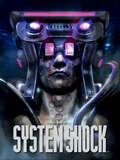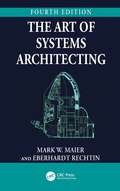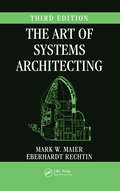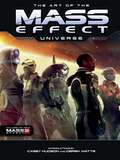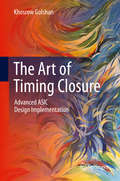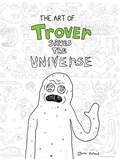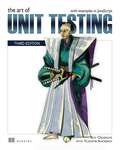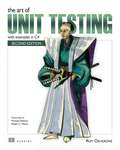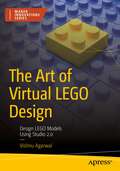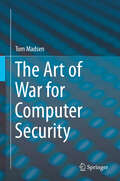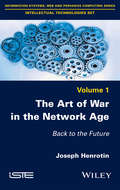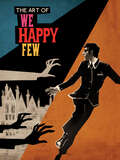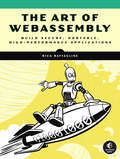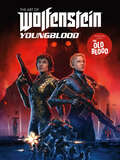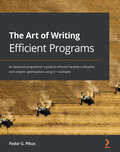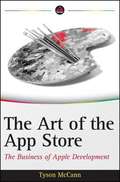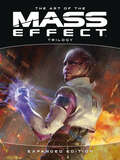- Table View
- List View
The Art of System Shock
by Robb WatersA full-color hardcover art book chronicling the renowned Nightdive Studios&’ faithful recreation of the iconic cyber-sci-fi action thriller video game, System Shock!When a powerful artificial intelligence named SHODAN is liberated of her ethical constraints, the inhabitants of the Citadel space station are rapidly corrupted into bloodthirsty cyborgs and mutants and placed under her control. It&’s up to a resourceful rogue hacker to traverse the station level by level, battling the monstrous crew and computer-controlled robots before ultimately facing down with the AI herself! Now fans of the groundbreaking cyber-action shooter can explore the development of the lovingly recreated System Shock in intricate detail—including art of Citadel Station&’s mysterious interiors, vile enemies, clever props, and much more. Nightdive Studios and Dark Horse Books invite readers to relive the unforgettable experience of the classic game, remade with enormous care for a new generation. Celebrate the return to Citadel Station with The Art of System Shock.
The Art of Systems Architecting
by Mark W. Maier Eberhardt RechtinThe Art of Systems Architecting, Fourth Edition, provides structured heuristics to improve the least structured, most art‑like elements of systems design. It offers unique techniques to bridge the difference between scientific engineering and qualitative design along with comprehensive methods for combining architectural design with digital engineering. This book illustrates how to go from model‑based systems architecture to model‑based systems engineering and includes case studies of good and bad architectural decision‑making in major systems.Changes to this edition include materials on architecture processes, architecture description frameworks, and integration with model‑based systems engineering (MBSE) and digital engineering. The publication of the ANSI/IEEE 1471 and ISO/IEC 42010 standards on architecture description has provided common vocabulary and organizing methods for documenting architectures. This edition provides a practical application of these standards in architecting and integrating their concepts with a simple process framework. The rise of MBSE and digital engineering tools is in the process of revolutionizing the development of complex systems. The emphasis has been on detailed design descriptions and powerful analysis methods (for example, digital twins). Architects can make effective use of these methods and tools as well, and this new edition provides an integrated set of heuristics and modeling methods to do so. There are many other improvements and additions included to bring this textbook up to date.This book can be used as a reference book for engineers and managers involved in creating new systems, people responsible for developing mandated architecture descriptions, software architects, system architects, and systems engineers, or as a textbook in graduate engineering courses.Exercises are interspersed throughout the text, with some designed for self‑testing and understanding and others intended to provide opportunities for long‑term study and further exploration of the subject.
The Art of Systems Architecting (Systems Engineering)
by Mark W. MaierIf engineering is the art and science of technical problem solving, systems architecting happens when you don't yet know what the problem is. The third edition of a highly respected bestseller, The Art of Systems Architecting provides in-depth coverage of the least understood part of systems design: moving from a vague concept and limited resources
The Art of The Last of Us (The Last of Us)
by VariousNaughty Dog Studios and Dark Horse proudly present the essential companion to The Last of Us, a richly detailed and compelling game set in a postpandemic world where humans have become an endangered species. Featuring concept art, character designs, and astonishing settings and landscapes, The Art of The Last of Us provides a unique look at one of the gaming world's most eagerly anticipated titles. * A must-have companion to the game. * Incredible full-color artwork! * The latest project from Naughty Dog Studios. * The Last of Us swept the top Game Critics awards at 2012's E3 conference.
The Art of The Mass Effect Universe (Mass Effect)
by Casey HusdonThe Mass Effect trilogy is a groundbreaking epic that has immersed gamers in one of science fiction's richest universes. Now BioWare and Dark Horse are proud to invite fans deeper than ever into the Mass Effect saga with The Art of the Mass Effect Universe! Featuring concept art and commentary by BioWare on the games' characters, locations, vehicles, weapons, and more (including Mass Effect 3) The Art of the Mass Effect Universe is the most complete companion available to gaming's most compelling series!
The Art of Timing Closure: Advanced ASIC Design Implementation
by Khosrow GolshanThe Art of Timing Closure is written using a hands-on approach to describe advanced concepts and techniques using Multi-Mode Multi-Corner (MMMC) for an advanced ASIC design implementation. It focuses on the physical design, Static Timing Analysis (STA), formal and physical verification. The scripts in this book are based on Cadence® Encounter System™. However, if the reader uses a different EDA tool, that tool’s commands are similar to those shown in this book.The topics covered are as follows:Data StructuresMulti-Mode Multi-Corner AnalysisDesign ConstraintsFloorplan and Timing Placement and TimingClock Tree SynthesisFinal Route and TimingDesign SignoffRather than go into great technical depth, the author emphasizes short, clear descriptions which are implemented by references to authoritative manuscripts. It is the goal of this book to capture the essence of physical design and timing analysis at each stage of the physical design, and to show the reader that physical design and timing analysis engineering should be viewed as a single area of expertise.This book is intended for anyone who is involved in ASIC design implementation -- starting from physical design to final design signoff. Target audiences for this book are practicing ASIC design implementation engineers and students undertaking advanced courses in ASIC design.
The Art of Tiny Tina's Wonderlands
by Amy RatcliffeA fantastic, full-color, oversized hardcover that chronicles the making of Gearbox&’s genre-mashing looter shooter!Go beyond the Borderlands with The Art of Tiny Tina&’s Wonderlands! Embark on a chaotic adventure that reimagines a cast of unforgettable characters as players journey through the Wonderlands. Admire the details of Tiny Tina&’s tabletop world in this handsome hardcover filled with the unique concept art of the environments, creatures, weapons, and characters we all know and love from the minds behind the Borderlands franchise! Join in the fun and become the ultimate Fatemaker by exploring The Art of Tiny Tina&’s Wonderlands! If you don't get it, Tiny Tina is gonna start crying!
The Art of Trover Saves the Universe
by Squanch GamesAn oversized full-color art book showcasing the insane imagination of Rick and Morty co-creator Justin Roiland! Save the universe! Save your dogs! Take your chair to the streets and follow Trover throughout the cosmos as you battle your way through hordes of clones on your quest to stop Glorkon! This freaky and awesome hardcover art book is the perfect companion to Squanch Games's first full length game! Feast your eye holes on 192 pages of crazy concept art and intimate commentary! Dark Horse Books and Squanch Games invite you to embrace weirdness by picking up the greatest art book in the galaxy! Or don't. It's whatever. I'm not your dad.
The Art of Uncharted 4: A Thief's End
by VariousJourney alongside Nathan Drake once again, as Naughty Dog and Dark Horse Books team up to bring you this comprehensive and breathtaking exploration into Uncharted 4: A Thief's End! Numerous never-before-seen designs and concept art accompanied by commentary from the developers give you behind-the-scenes access to the creation of this gaming masterwork. This beautiful oversized hardcover is a must-have for any fan of the Uncharted franchise and high quality video game art.The Art of Unchartend 4 will be released by Dark Horse simultaneoulsy with the new game, Uncharted 4.
The Art of Unit Testing, Third Edition: with examples in JavaScript (The Art of)
by Roy OsheroveUnit testing is more than just a collection of tools and practices—it&’s a state of mind! This bestseller reveals the master&’s secrets for delivering robust, maintainable, and trustworthy code.Thousands of developers have learned to hone their code quality under the tutelage of The Art of Unit Testing. This revised third edition updates an international bestseller to reflect modern development tools and practices, as well as to cover JavaScript. Inside The Art of Unit Testing, Third Edition you will learn how to: Create readable, maintainable, and trustworthy tests Work with fakes, stubs, mock objects, and isolation frameworks Apply simple dependency injection techniques Refactor legacy code with confidence Test both frontend and backend code Effective unit tests streamline your software development process and ensure you deliver consistent high-quality code every time. With practical examples in JavaScript and Node, this hands-on guide takes you from your very first unit tests all the way to comprehensive test suites, naming standards, and refactoring techniques. You&’ll explore test patterns and organization, working with legacy code and even &“untestable&” code. The many tool-agnostic examples are presented in JavaScript and carefully designed so that they apply to code written in any language. About the technology The art of unit testing is more than just learning the right collection of tools and practices. It&’s about understanding what makes great tests tick, finding the right strategy for each unique situation, and knowing what to do when the testing process gets messy. This book delivers insights and advice that will transform the way you test your software. About the book The Art of Unit Testing, Third Edition shows you how to create readable and maintainable tests. It goes well beyond basic test creation into organization-wide test strategies, troubleshooting, working with legacy code, and &“merciless&” refactoring. You&’ll love the practical examples and familiar scenarios that make testing come alive as you read. This third edition has been updated with techniques specific to object-oriented, functional, and modular coding styles. The examples use JavaScript. What's inside Deciding on test types and strategies Test Entry & Exit Points Refactoring legacy code Fakes, stubs, mock objects, and isolation frameworks Object-Oriented, Functional, and Modular testing styles About the reader Examples use JavaScript, TypeScript, and Node.js. About the author Roy Osherove is an internationally-recognized expert in unit testing and agile software methodology. Vladimir Khorikov is the author of Manning&’s Unit Testing Principles, Practices, and Patterns, a Pluralsight author, and a Microsoft MVP. Table of Contents PART 1 1 The basics of unit testing 2 A first unit test PART 2 3 Breaking dependencies with stubs 4 Interaction testing using mock objects 5 Isolation frameworks 6 Unit testing asynchronous code PART 3 7 Trustworthy tests 8 Maintainability PART 4 9 Readability 10 Developing a testing strategy 11 Integrating unit testing into the organization 12 Working with legacy code Appendix Monkey-patching functions and modules
The Art of Unit Testing: with examples in C#
by Roy OsheroveSummaryThe Art of Unit Testing, Second Edition guides you step by step from writing your first simple tests to developing robust test sets that are maintainable, readable, and trustworthy. You'll master the foundational ideas and quickly move to high-value subjects like mocks, stubs, and isolation, including frameworks such as Moq, FakeItEasy, and Typemock Isolator. You'll explore test patterns and organization, working with legacy code, and even "untestable" code. Along the way, you'll learn about integration testing and techniques and tools for testing databases and other technologies.About this BookYou know you should be unit testing, so why aren't you doing it? If you're new to unit testing, if you find unit testing tedious, or if you're just not getting enough payoff for the effort you put into it, keep reading.The Art of Unit Testing, Second Edition guides you step by step from writing your first simple unit tests to building complete test sets that are maintainable, readable, and trustworthy. You'll move quickly to more complicated subjects like mocks and stubs, while learning to use isolation (mocking) frameworks like Moq, FakeItEasy, and Typemock Isolator. You'll explore test patterns and organization, refactor code applications, and learn how to test "untestable" code. Along the way, you'll learn about integration testing and techniques for testing with databases.The examples in the book use C#, but will benefit anyone using a statically typed language such as Java or C++.Purchase of the print book includes a free eBook in PDF, Kindle, and ePub formats from Manning Publications.What's InsideCreate readable, maintainable, trustworthy testsFakes, stubs, mock objects, and isolation (mocking) frameworksSimple dependency injection techniquesRefactoring legacy codeAbout the AuthorRoy Osherove has been coding for over 15 years, and he consults and trains teams worldwide on the gentle art of unit testing and test-driven development. His blog is at ArtOfUnitTesting.com.Table of ContentsPART 1 GETTING STARTEDThe basics of unit testingA first unit testPART 2 CORE TECHNIQUESUsing stubs to break dependenciesInteraction testing using mock objectsIsolation (mocking) frameworksDigging deeper into isolation frameworksPART 3 THE TEST CODETest hierarchies and organizationThe pillars of good unit testsPART 4 DESIGN AND PROCESSIntegrating unit testing into the organizationWorking with legacy code Design and testability
The Art of Virtual LEGO Design: Design LEGO Models Using Studio 2.0
by Vishnu AgarwalHave you ever dreamed of designing your own LEGOs? Do you love building huge LEGO models, but don’t have enough bricks? This book will show you how to do all that and more with Bricklink Studio 2.0, a software program that's widely used by LEGO designers to create LEGO models virtually before making them with real LEGO bricks. You'll learn how to start a new project, use the camera control options, and drag and drop parts into your building plate. Then take your bricks from a pile of random pieces into intricate masterpiece models using building tools like Select, Hinge, Clone, Hide, Connect, Collision, and more! You’ll master all the building tools that help you build LEGO models. Then you’ll learn to search and manage LEGO bricks in Studio 2.0 using different palette options like Master, Hidden parts, and Custom parts. Beyond the official LEGO colors, there are special color options you can use to render neon, glow in the dark, and translucent brick. Use this expanded color palette to add to the complexity of your models, and then render your model to see it realistically in 3D! You’ll also learn to animate your model and watch it come to life. After finishing your design, you’ll learn to share what you’ve built with the world. You’ll create professional LEGO instructions for your model that can be printed or shared. Making you a true LEGO design master! What You'll LearnMake fascinating models with virtual LEGO bricks Design LEGO models more efficiently with Studio 2.0’s powerful tools Use “Build Together” simultaneously with another designer on the same project Build massive, amazing models on a small budget Who This Book Is ForAnyone interested in digital modelling or who loves building with LEGOs. Students, hobbyists, and enthusiasts will find fun learning activities.
The Art of War for Computer Security
by Tom MadsenIn this book the author draws inspiration from Sun Tzu's Art of War, a work that explains conflict between nations, and he applies this to the computer security setting, examining how we should consider protecting information systems from accidents or malicious attacks. The author first briefly introduces Sun Tzu. Then each chapter in the book takes its inspiration from an original title in The Art of War, where the author offers a general introduction to the content and then describes its application in a cybersecurity setting. These chapters cover estimates; waging war; offensive strategy; how you prepare for an attack; energy; weaknesses and strengths; the variables that need consideration before embarking on a war; how infrastructure is related to the concept of ground; attack by fire or how skilled attackers hide behind noise; and employing secret agents. The book will be interesting for computer security researchers and professionals who would like some grounding in a security mindset.
The Art of War in the Network Age: Back to the Future
by Joseph HenrotinExamining the influence of information technology on the art of war theoretical structure and, beyond, the concrete effects of those technologies on the conduct of war (thus, not warfare) itself. What could be the influence of information technology on the art of war theoretical structure and, beyond, what are the concrete effects of those technologies on the conduct of war itself? "Art build upon a science", strategy is often forgotten by publications dealing with the impacts of technology on warfare, but are network-centric warfare and all those technological artefacts really a revolution for war? The interaction of theoretical strategy and information networks has not really been systematically treated before this book.
The Art of We Happy Few
by Compulsion GamesThe official art book to the game! Two-hundred pages of mind-bending art and insightful creator commentary exploring the conceptualization and execution of We Happy Few!October, 1964. The City of Wellington Wells is all that's left of England after the German invasion and four years of occupation. But it's still the swinging '60s, and everyone is fab, especially because they're taking happy pills--Joy--and wearing Happy Face masks so they're always smiling . . . everyone except the awful Downers who live in the abandoned Garden District and refuse to take their Joy. Dark Horse Books and Compulsion Games are thrilled to present The Art of We Happy Few. Showcasing a unique retro-futuristic style, this book includes hundreds of pieces of concept art, paired with exclusive commentary from the team that created it! Don't be a Downer by missing out on this perfect companion to the psychedelic videogame experience!
The Art of WebAssembly: Build Secure, Portable, High-Performance Applications
by Rick BattaglineA a thorough, practice-based introduction to WebAssembly. Learn how to create high-performing, lightning-fast websites and applications. WebAssembly is the fast, compact, portable technology that optimizes the performance of resource-intensive web applications and programs. The Art of WebAssembly is designed to give web developers a solid understanding of how it works, when to use it (and when not to), and how to develop and deploy WebAssembly apps. First you&’ll learn how to optimize and compile low-level code, debug and evaluate WebAssembly, and represent WebAssembly in the human-readable WebAssembly Text (WAT) format. Once you have the basics down, you&’ll build a browser-based collision detection program, work with browser rendering technologies to create graphics and animations, and see how WebAssembly interacts with other web languages. You&’ll also learn how to: • Embed WebAssembly applications in web browsers and Node.js • Use browser debuggers to evaluate your WebAssembly code • Format variables, loops, functions, strings, data structures, and conditional logic in WAT • Manipulate memory • Build a program that generates graphical objects and detects when they collide • Evaluate the output of a WebAssembly compiler The Art of WebAssembly will help you make sense of this powerful technology to boost the performance of your web applications.
The Art of Wireless Sensor Networks
by Habib M. AmmariDuring the last one and a half decades, wireless sensor networks have witnessed significant growth and tremendous development in both academia and industry. "The Art of Wireless Sensor Networks: Volume 1: Fundamentals" focuses on the fundamentals concepts in the design, analysis, and implementation of wireless sensor networks. It covers the various layers of the lifecycle of this type of network from the physical layer up to the application layer. Its rationale is that the first volume covers contemporary design issues, tools, and protocols for radio-based two-dimensional terrestrial sensor networks. All the book chapters in this volume include up-to-date research work spanning various classic facets of the physical properties and functional behavior of wireless sensor networks, including physical layer, medium access control, data routing, topology management, mobility management, localization, task management, data management, data gathering, security, middleware, sensor technology, standards, and operating systems. This book will be an excellent source of information for both senior undergraduate and graduate students majoring in computer science, computer engineering, electrical engineering, or any related discipline. In addition, computer scientists, researchers, and practitioners in both academia and industry will find this book useful and interesting.
The Art of Wolfenstein II: The New Colossus
by MachineGamesImmerse yourself in a world brought to life by unforgettable characters in a 1960s America flipped upside down by Nazi occupation!Overflowing with concept art, production material, and exclusive commentary from the creators of the newest entry in the epochal action franchise, this beautiful hardcover belongs in the collection of freedom fighters, gamers, and art fans everywhere!Dark Horse Books, Machine Games, and Bethesda Softworks are proud to present the perfect companion to Wolfenstein II: The New Colossus.
The Art of Wolfenstein: Youngblood
by MachineGames Bethesda SoftworksA full-color digital book chronicling the development of the next entry in the iconic first-person shooter franchise.It's do or die in the dystopian streets of Nazi-occupied Paris as Jess and Soph Blazkowicz piece together the mysterious disappearance of their father, William J. Blazkowicz, while driving the fascists out of France once and for all.This gorgeous volume features an amazing arsenal of concept art, production material, and exclusive creator commentary from the latest romp into Earth's alternate history with Wolfenstein: Youngblood. Dark Horse Books, MachineGames, and Bethesda Softworks call all sisters, brothers, and other champions for the cause to unite, fight, and enjoy The Art of Wolfenstein: Youngblood!
The Art of Writing Efficient Programs: An advanced programmer's guide to efficient hardware utilization and compiler optimizations using C++ examples
by Fedor G. PikusBecome a better programmer with performance improvement techniques such as concurrency, lock-free programming, atomic operations, parallelism, and memory managementKey FeaturesLearn proven techniques from a heavyweight and recognized expert in C++ and high-performance computingUnderstand the limitations of modern CPUs and their performance impactFind out how you can avoid writing inefficient code and get the best optimizations from the compilerLearn the tradeoffs and costs of writing high-performance programsBook DescriptionThe great free lunch of "performance taking care of itself" is over. Until recently, programs got faster by themselves as CPUs were upgraded, but that doesn't happen anymore. The clock frequency of new processors has almost peaked, and while new architectures provide small improvements to existing programs, this only helps slightly. To write efficient software, you now have to know how to program by making good use of the available computing resources, and this book will teach you how to do that. The Art of Efficient Programming covers all the major aspects of writing efficient programs, such as using CPU resources and memory efficiently, avoiding unnecessary computations, measuring performance, and how to put concurrency and multithreading to good use. You'll also learn about compiler optimizations and how to use the programming language (C++) more efficiently. Finally, you'll understand how design decisions impact performance. By the end of this book, you'll not only have enough knowledge of processors and compilers to write efficient programs, but you'll also be able to understand which techniques to use and what to measure while improving performance. At its core, this book is about learning how to learn.What you will learnDiscover how to use the hardware computing resources in your programs effectivelyUnderstand the relationship between memory order and memory barriersFamiliarize yourself with the performance implications of different data structures and organizationsAssess the performance impact of concurrent memory accessed and how to minimize itDiscover when to use and when not to use lock-free programming techniquesExplore different ways to improve the effectiveness of compiler optimizationsDesign APIs for concurrent data structures and high-performance data structures to avoid inefficienciesWho this book is forThis book is for experienced developers and programmers who work on performance-critical projects and want to learn new techniques to improve the performance of their code. Programmers in algorithmic trading, gaming, bioinformatics, computational genomics, or computational fluid dynamics communities will get the most out of the examples in this book, but the techniques are fairly universal. Although this book uses the C++ language, the concepts demonstrated in the book can be easily transferred or applied to other compiled languages such as C, Java, Rust, Go, and more.
The Art of iPhone Photography
by Nicki Fitz-Gerald Bob WeilThe Art of iPhone Photography explores how 45 of today's best iPhonegraphers from around the world conceived, composed, and created some of their finest and best-known pieces-all in their own words. Through an understanding of the artists' visions, creative decisions, and techniques, beginning through advanced iPhoneographers will immediately be able to apply what they learn and take their own photographic art to the next level.Key features of the book include: A wide variety of styles and subjects: Landscapes, street photography, abstracts, architecture, portraits, collages, concept pieces, etc. Detailed tutorials: Example artworks from authors and contributing photographers accompanied by descriptions of how each piece was created from both a creative and technical standpoint Explanations for practical use of nearly 100 apps, including BlurFX, Camera+, Iris Photo Suite (now Laminar), Juxtaposer, Photogene2, Pixlr-o-matic, ScratchCam FX, Snapseed, Superimpose, and TouchRetouch iPhoneography gallery: A stunning showcase of works by notable iPhoneographersAlways on, always at hand, and inconspicuously deployed, today's smartphones empower us to record the world in ever newer and more personal ways. By leveraging the photo-editing applications found on the iPhone, professional and amateur photographers alike are able to create not only editorial imagery, but also creative art. "Nicki Fitz-Gerald and Bob Weil, at iPhoneographyCentral.com, have built a community dedicated to the burgeoning collaboration between art and technology that is iPhoneography. Their site, and now this book, offer extensive, in-depth tutorials both for budding iPhoneographers looking to advance their craft, and professionals attempting to harness a new toolkit in service of their vision. What they bring to the table is their belief that 'revealing the man behind the curtain' does not diminish the teacher. Technique does not the artist make, but it does enable the newcomer to find his or her own voice. With thousands of apps available and more flooding the market daily, every new iPhoneographer wonders, What apps should I use? The answer to that question is so complex, with so many variables, that an illustrated tutorial such as this becomes an invaluable tool. There is really nothing like it. It does not offer the advice of a single artist or showcase images from a small artistic segment. Indeed, it offers up stories, knowledge, tips, and secrets from many of the key players in the formation of this movement, showcasing more than 40 artists and tutorials and 80 pages of iPhonic art." - Daria Polichetti, Co-Founder of Los Angeles Mobile Arts Festival
The Art of the App Store
by Tyson MccannA unique behind-the-scenes look at what makes an application succeed in the App Store With this invaluable book, Tyson McCann offers a non-technical look at all aspects of the iPhone application development landscape and gets to the core of what makes a popular-and profitable-application. From knowing your customer to to launching a successful app, and everything in between, this must-have guide navigates such topics as developing a concept, analyzing the competition, considerations before the launch, marketing, building a community, and maintaining market share… to name a few. Coverage includes: • Setting Your Goals, Costs, and Expectations • Researching the App Store Market • Knowing Your Customer • Plotting the Stages of Development • Guidelines and Expectations for Developing Your App • Creating Free and Freemium Apps • Creating Paid and Premium Apps • Adopting Apple's Approach • Riding the Social Networking Wave • Feedback, Maintaining, and Scaling Open the vault to App Store success with this indispensable guide!
The Art of the App Store
by Tyson MccannA unique behind-the-scenes look at what makes an application succeed in the App StoreWith this invaluable book, Tyson McCann offers a non-technical look at all aspects of the iPhone application development landscape and gets to the core of what makes a popular--and profitable--application. From knowing your customer to to launching a successful app, and everything in between, this must-have guide navigates such topics as developing a concept, analyzing the competition, considerations before the launch, marketing, building a community, and maintaining market share... to name a few.Coverage includes:Setting Your Goals, Costs, and ExpectationsResearching the App Store MarketKnowing Your CustomerPlotting the Stages of DevelopmentGuidelines and Expectations for Developing Your AppCreating Free and Freemium AppsCreating Paid and Premium AppsAdopting Apple's ApproachRiding the Social Networking WaveFeedback, Maintaining, and ScalingOpen the vault to App Store success with this indispensable guide!
The Art of the Last of Us Part II
by Naughty DogFollow Ellie's profound and harrowing journey of vengeance through an exhaustive collection of original art and intimate creator commentary in the full-color hardcover volume: The Art of The Last of Us Part II.Created in collaboration between Dark Horse Books and the developers at Naughty Dog, The Art of The Last of Us Part II offers extensive insights into the making of the long-awaited sequel to the award-winning The Last of Us.
The Art of the Mass Effect Trilogy: Expanded Edition
by BiowareExpanded with never before seen works of art, this new edition delves deeper than ever into the sci-fi saga that changed video games forever.Contains extensive new material from the DLCs for all three games--including the award-winning "Lair of the Shadow Broker" from Mass Effect 2 and the fan-favorite "Citadel" from Mass Effect 3. Experience the evolution of the aliens, planets, ships, and technology that define this iconic science fiction universe, as the developers who brought BioWare's masterpiece to life take you from the earliest design sketches through to the meticulous final renders.Brimming with concept art and commentary, this expanded edition is the ultimate companion to one of the greatest series in the history of gaming!
